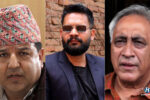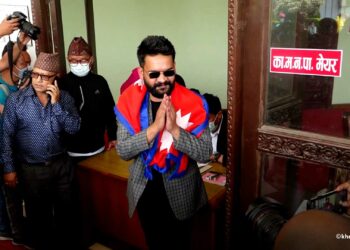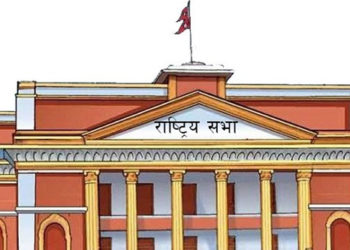Nepal has been moving through the process of peaceful transition since the comprehensive peace agreement signed in November 2006 between the Maoists and the Nepali Government.
Unfortunately, there are no linear, predetermined, and predictable paths for a full-fledged democracy in Nepal, which may resolve the problems of human insecurity and carry development programs, matching the peoples’ expectations and strengthen both the political parties and civil society organizations for significant change and consolidate democracy that may protect individuals also from fear and provide the freedom they have for so long been cherishing.
Social movements do not evolve overnight; they need time to mature and there is a lot of volatility in such a process about which the prominent Belgian politician Yves Laterme writes at length in the preface of her book titled Democratic Transitions: Convention with World Leaders. If there is an efficient link between the state and the society along with an effective articulation through association, then good governance may be epitomized by predictable and enlightened policymaking in the form of federalism and devolution and that would be most appropriate as well.
Some observers feel that democracy has become a tool in the hands of a few ruling elites to serve their self-serving interests and selfish motives as opposed to having a genuine desire to empower people. Such developments are an indication of democratic decay.
The problems of a South Asian democracy are often rooted in its leader dominant party politics and government, which is plagued by ineffective short-term policies, wrongly set priorities, weak governing institutions, and political instability; they still want to replace the iron triangle with a more accountable governance, and more direct robust participation by the electorate.
Some observers feel that democracy has become a tool in the hands of a few ruling elites to serve their self-serving interests and selfish motives as opposed to having a genuine desire to empower people. Such developments are an indication of democratic decay.
No single mode suits all countries. It must be said that citizens ordinarily pay only cursory attention to politics and so tend to involve themselves minimally; nevertheless, they can make coherent political ideas and even appreciate the core ideas of liberalism and conservatism while organizing their political responses.
No doubt, it could be argued that it was a revolutionary process of change toward a new direction; it may alter the policy process with a clear understanding of federalism that also follows the latest republican democracy in the country whose political tradition is still heavily associated with the classic parliamentary order.
The constituent assembly (CA) elections (2008 and 2013) which ultimately delivered the written constitution constitutes a watershed in Nepali politics, actualizing the devolution of authority and paving ways to give voice to the voiceless. However, the crucial challenge is how political leadership would champion liberal governance, and how the citizens would get involved in new policy platforms and social relationships of responsibility, accountability, and participation.
It is perhaps here that the role of political parties would be most critical. We find that the May 18 (2008) declaration by Nepal’s parliament ending the country’s distinction as the world’s only Hindu state was one of several hard decisions taken by the new government. No doubt, it could be argued that it was a revolutionary process of change toward a new direction; it may alter the policy process with a clear understanding of federalism that also follows the latest republican democracy in the country whose political tradition is still heavily associated with the classic parliamentary order.
In most of the political history of Nepal, the monarchy has dominated in the political offices both at the national and local levels; so, it must bear the lion’s share of the blame for governance failures. Now that both the regional and local governments may prioritize their aggregate economic and development gains for the most vulnerable and at the same time national political leaders and other officials could shape the transition process in a mature manner by presenting a pragmatic vision through both long-term goals and modest promises, we may expect that what will emerge in the future would be a worthy democratic government and sound political culture in Nepal.
In the current setting, an ongoing conflict against the state is a familiar scenario that continues to confront nearly all the countries of South Asia.
Accepting that constitutional changes are inevitable, questions remain: whether a certain path leads to a legitimate change and whether there are limits to it. Democracy by definition is a competitive process, and competition, according to Lisa Anderson, challenges those who can rationalize their commitment to it and with an even greater edge to those who sincerely believe in it.
But the second question poses a larger intellectual challenge: Could a ‘democratic’ or ‘civilized’ state be better mobilized and stretched out so as to acquire the capacity to act in cohesion with the established practices of tolerance and be enlightened to promote actions more effectively to prevent deadly conflicts and keep the existing peace in place? While people may never feel free under absolute power, a society could be democratic for the most part, if important issues and crises are decided by the overwhelming majority of the people rather than by those at the top of the power pyramid.
In the current setting, an ongoing conflict against the state is a familiar scenario that continues to confront nearly all the countries of South Asia. This is partly due to their political culture, where people get to vote occasionally for leaders, and then leave it all in their hands, leading to excessive reliance on ‘them’ and turning toward them only when things don’t get right.
In Nepal’s case, it got rid of the monarchy because it was believed that it had a certain, so-called divine right to rule, which would be a glaring anachronism in the 21st century. But, it does not leave a shred of doubt lingering that formidable obstacles stand in the way of realizing the ultimate outcome of a modern political state through constitutional politics characterized with both mass mobilization and civic virtues.
True, there is plenty of blame game going around, but it is for us as voters to remain optimistic about the ability of Nepali politicians to deliver transformative changes. In the past ten years, Nepal has turned a new leaf which is considered as a form of acceptance of the concepts of democratic governance where the people’s requirements may be articulated and their rights exercised for peaceful coexistence.
However, Nepal today is also in a desperate need of democratic solutions to reconcile and avoid aggravating the ethnic and cultural differences, which can jeopardize the whole democratic progress. This means that full consolidation of democracy is a long-term endeavor and the road may be quite bumpy. This situation compels the leadership to collaborate and cooperate because the core of the democratic system is centered on inclusiveness, transparency, and accountability.
Finally, after elucidating path of the tortuous course that democratization has taken in Nepal, I would take up two issues which are vital to sustaining democracy here, as anywhere else. The first one of them is the Positive Peace which offers a theory of change to explain the functioning of a nation or society and why highly peaceful societies thrive.
In brief, positive peace implies the attitudes, institutions, and structures that create and sustain peaceful societies. The paucity of space and time disallows me to take up here more than two of the eight pillars of positive peace which have a direct bearing on the central theme of this paper—acceptance of the right of others at both the citizen and state levels, and good relations with neighbors.
The critical salience of positive peace for Nepal at a time when its democratic transition is still underway and highly vulnerable to pressures, interventions, and intrusions from neighbors from either side, not to mention growth and development in this decade and beyond, is hard to exaggerate and may remain a matter of conjecture, given the uncertain and often highly unpredictable mode of relations Nepal’s political transition has entered.
Relations between two states, the third factor is an element commonly alluded to and used, but is like an iceberg whose tip as visible with most of its body left untouched. In such a context, the Relational Deficit that mars the relations between Nepal and India and is a direct function of the outdated Statism and Realpolitik in the foreign policy of both countries demands a close, long, hard look to rectify the problems that have now become chronic and formidably complex. The earlier the efforts come, the better for both countries.
Views expressed in this article are the author’s own and do not necessarily reflect the stance of Khabarhub.









Comment